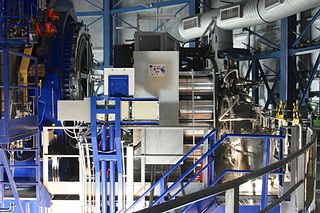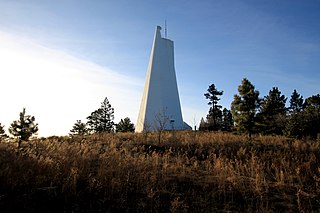
The Very Large Telescope (VLT) is an astronomical facility operated since 1998 by the European Southern Observatory, located on Cerro Paranal in the Atacama Desert of northern Chile. It consists of four individual telescopes, each equipped with a primary mirror that measures 8.2 meters in diameter. These optical telescopes, named Antu, Kueyen, Melipal, and Yepun, are generally used separately but can be combined to achieve a very high angular resolution. The VLT array is also complemented by four movable Auxiliary Telescopes (ATs) with 1.8-meter apertures.

Interferometry is a technique which uses the interference of superimposed waves to extract information. Interferometry typically uses electromagnetic waves and is an important investigative technique in the fields of astronomy, fiber optics, engineering metrology, optical metrology, oceanography, seismology, spectroscopy, quantum mechanics, nuclear and particle physics, plasma physics, biomolecular interactions, surface profiling, microfluidics, mechanical stress/strain measurement, velocimetry, optometry, and making holograms.

The W. M. Keck Observatory is an astronomical observatory with two telescopes at an elevation of 4,145 meters (13,600 ft) near the summit of Mauna Kea in the U.S. state of Hawaii. Both telescopes have 10 m (33 ft) aperture primary mirrors, and, when completed in 1993 and 1996, they were the largest optical reflecting telescopes in the world. They have been the third and fourth largest since 2006.

Adaptive optics (AO) is a technique of precisely deforming a mirror in order to compensate for light distortion. It is used in astronomical telescopes and laser communication systems to remove the effects of atmospheric distortion, in microscopy, optical fabrication and in retinal imaging systems to reduce optical aberrations. Adaptive optics works by measuring the distortions in a wavefront and compensating for them with a device that corrects those errors such as a deformable mirror or a liquid crystal array.

The Gemini Observatory comprises two 8.1-metre (26.6 ft) telescopes, Gemini North and Gemini South, situated in Hawaii and Chile, respectively. These twin telescopes offer extensive coverage of the northern and southern skies and rank among the most advanced optical/infrared telescopes available to astronomers. (See List of largest optical reflecting telescopes).

The Swedish 1-m Solar Telescope is a refracting solar telescope at Roque de los Muchachos Observatory, La Palma in the Canary Islands. It is run by the Institute for Solar Physics of Stockholm University. The primary element is a single fused silica lens, making it the largest optical refracting telescope in use in the world. The Swedish 1-m Solar Telescope, with a lens diameter of 43 inches, is technically larger than Yerkes Observatory, only 39 inches are clear for the aperture. The SST is most often used as a Schupmann telescope, thereby correcting the chromatic aberrations of the singlet primary.

The Giant Magellan Telescope (GMT) is a ground-based, extremely large telescope currently under construction at Las Campanas Observatory in Chile's Atacama Desert. With a primary mirror diameter of 25.4 meters, it is expected to be the largest Gregorian telescope ever built, observing in optical and mid-infrared wavelengths. Commissioning of the telescope is anticipated in the early 2030s.

Transition Region and Coronal Explorer was a NASA heliophysics and solar observatory designed to investigate the connections between fine-scale magnetic fields and the associated plasma structures on the Sun by providing high-resolution images and observation of the solar photosphere, the transition region, and the solar corona. A main focus of the TRACE instrument is the fine structure of coronal loops low in the solar atmosphere. TRACE is the third spacecraft in the Small Explorer program, launched on 2 April 1998, and obtained its last science image on 21 June 2010, at 23:56 UTC.

The Multi-Unit Spectroscopic Explorer (MUSE) is an integral field spectrograph installed at the Very Large Telescope (VLT) of the European Southern Observatory (ESO). It operates in the visible wavelength range, and combines a wide field of view with a high spatial resolution and a large simultaneous spectral range. It is specifically designed to take advantage of the improved spatial resolution provided by adaptive optics, offering diffraction-limited performance in specific configurations. MUSE had first light on the VLT’s Unit Telescope 4 (UT4) on 31 January 2014.

The Southern Astrophysical Research (SOAR) telescope is a modern 4.1-meter (13 ft) aperture optical and near-infrared telescope located on Cerro Pachón, Chile at 2,738 metres (8,983 ft) elevation. It was commissioned in 2003, and is operated by a consortium including the countries of Brazil and Chile, Michigan State University, the Cerro Tololo Inter-American Observatory (CTIO), and the University of North Carolina at Chapel Hill. Partners have guaranteed shares varying from 10 to 30 percent of the observing time.

McMath–Pierce solar telescope is a 1.6 m f/54 reflecting solar telescope at Kitt Peak National Observatory in Arizona, United States. Built in 1962, the building was designed by American architect Myron Goldsmith and Bangladeshi-American structural engineer Fazlur Rahman Khan. It was the largest solar telescope and the largest unobstructed aperture optical telescope in the world. It is named after the astronomers Robert Raynolds McMath and Keith Pierce.

The Dunn Solar Telescope, also known as the Richard B. Dunn Solar Telescope, is a unique vertical-axis solar telescope that specializes in high-resolution imaging and spectroscopy. It is located at Sacramento Peak in Sunspot, New Mexico. It is the main telescope at the Sunspot Solar Observatory, operated by New Mexico State University in partnership with the National Solar Observatory through funding from the National Science Foundation, the state of New Mexico, and private funds from other partners. The Dunn Solar Telescope helps astrophysicists worldwide better understand the Sun and how it affects Earth.

Big Bear Solar Observatory (BBSO) is a university-based solar observatory in the United States. It is operated by New Jersey Institute of Technology (NJIT). BBSO has a 1.6-meter (5.2 ft) clear-aperture Goode Solar Telescope (GST), which has no obscuration in the optical train. BBSO is located on the north side of Big Bear Lake in the San Bernardino Mountains of southwestern San Bernardino County, California, approximately 120 kilometers east of downtown Los Angeles. The telescopes and instruments at the observatory are designed and employed specifically for studying the activities and phenomena of the Sun.

Hinode, formerly Solar-B, is a Japan Aerospace Exploration Agency Solar mission with United States and United Kingdom collaboration. It is the follow-up to the Yohkoh (Solar-A) mission and it was launched on the final flight of the M-V rocket from Uchinoura Space Center, Japan on 22 September 2006 at 21:36 UTC. Initial orbit was perigee height 280 km, apogee height 686 km, inclination 98.3 degrees. Then the satellite maneuvered to the quasi-circular Sun-synchronous orbit over the day/night terminator, which allows near-continuous observation of the Sun. On 28 October 2006, the probe's instruments captured their first images.

The Daniel K. Inouye Solar Telescope (DKIST) is a scientific facility for studies of the Sun at Haleakala Observatory on the Hawaiian island of Maui. Known as the Advanced Technology Solar Telescope (ATST) until 2013, it was named after Daniel K. Inouye, a US Senator for Hawaii. It is the world's largest solar telescope, with a 4-meter aperture. The DKIST is funded by National Science Foundation and managed by the National Solar Observatory. The total project cost is $344.13 million. It is a collaboration of numerous research institutions. Some test images were released in January 2020. The end of construction and transition into scientific observations was announced in November 2021.
The Sunrise balloon-borne solar observatory consists of a 1m aperture Gregory telescope, a UV filter imager, an imaging vector polarimeter, an image stabilization system and further infrastructure. The first science flight of Sunrise yielded high-quality data that reveal the structure, dynamics and evolution of solar convection, oscillations and magnetic fields at a resolution of around 100 km in the quiet Sun.

The Gemini Planet Imager (GPI) is a high contrast imaging instrument that was built for the Gemini South Telescope in Chile. The instrument achieves high contrast at small angular separations, allowing for the direct imaging and integral field spectroscopy of extrasolar planets around nearby stars. The collaboration involved in planning and building the Gemini Planet imager includes the American Museum of Natural History (AMNH), Dunlap Institute, Gemini Observatory, Herzberg Institute of Astrophysics (HIA), Jet Propulsion Laboratory, Lawrence Livermore National Lab (LLNL), Lowell Observatory, SETI Institute, The Space Telescope Science Institute (STSCI), the University of Montreal, University of California, Berkeley, University of California, Los Angeles (UCLA), University of California, Santa Cruz (UCSC), University of Georgia.

Philip R. Goode is an American theoretical physicist also working in observational astronomy and its instrumentation. He is a Distinguished Research Professor of Physics at New Jersey Institute of Technology (NJIT) with an H-index > 60. His career divides into five overlapping periods as follows:

The NIRSpec is one of the four scientific instruments flown on the James Webb Space Telescope (JWST). The JWST is the follow-on mission to the Hubble Space Telescope (HST) and is developed to receive more information about the origins of the universe by observing infrared light from the first stars and galaxies. In comparison to HST, its instruments will allow looking further back in time and will study the so-called Dark Ages during which the universe was opaque, about 150 to 800 million years after the Big Bang.

NIRCam is an instrument aboard the James Webb Space Telescope. It has two major tasks, as an imager from 0.6 to 5 μm wavelength, and as a wavefront sensor to keep the 18-section mirrors functioning as one. In other words, it is a camera and is also used to provide information to align the 18 segments of the primary mirror. It is an infrared camera with ten mercury-cadmium-telluride (HgCdTe) detector arrays, and each array has an array of 2048×2048 pixels. The camera has a field of view of 2.2×2.2 arcminutes with an angular resolution of 0.07 arcseconds at 2 μm. NIRCam is also equipped with coronagraphs, which helps to collect data on exoplanets near stars. It helps with imaging anything next to a much brighter object, because the coronagraph blocks that light.




















